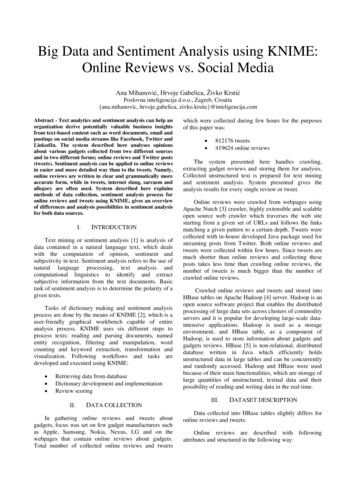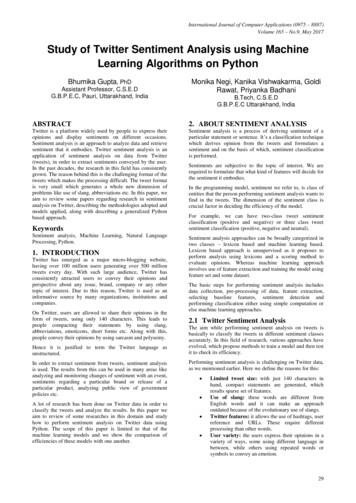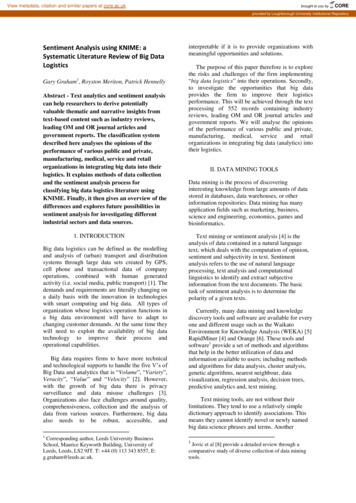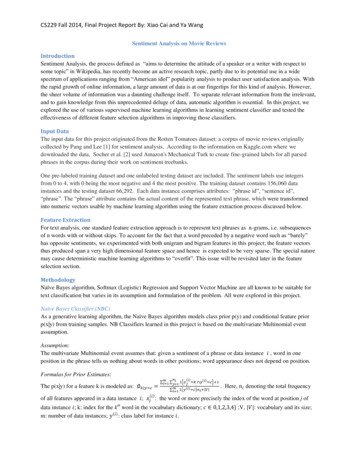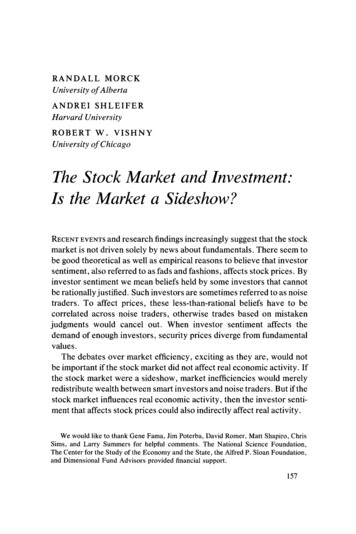
Transcription
Sentiment Analysis for Movie ReviewsAnkit Goyal, a3goyal@ucsd.eduAmey Parulekar, aparulek@ucsd.eduIntroduction:Movie reviews are an important way to gauge the performance of a movie. While providing anumerical/stars rating to a movie tells us about the success or failure of a movie quantitatively,a collection of movie reviews is what gives us a deeper qualitative insight on different aspects ofthe movie. A textual movie review tells us about the the strong and weak points of the movie anddeeper analysis of a movie review can tell us if the movie in general meets the expectations ofthe reviewer.Sentiment Analysis[1] is a major subject in machine learning which aims to extract subjectiveinformation from the textual reviews. The field of sentiment of analysis is closely tied to naturallanguage processing and text mining. It can be used to determine the attitude of the reviewerwith respect to various topics or the overall polarity of review. Using sentiment analysis, we canfind the state of mind of the reviewer while providing the review and understand if the personwas “happy”, “sad”, “angry” and so on.In this project we aim to use Sentiment Analysis on a set of movie reviews given by reviewers andtry to understand what their overall reaction to the movie was, i.e. if they liked the movie or theyhated it. We aim to utilize the relationships of the words in the review to predict the overallpolarity of the review.Dataset:The dataset used for this task was collected from Large Movie Review Dataset[2] which was usedby the AI department of Stanford University for the associated publication [3]. The datasetcontains 50,000 training examples collected from IMDb[4] where each review is labelled with therating of the movie on scale of 1-10. As sentiments are usually bipolar like good/bad or happy/sador like/dislike, we categorized these ratings as either 1 (like) or 0 (dislike) based on the ratings. Ifthe rating was above 5, we deduced that the person liked the movie otherwise he did not.Initially the dataset was divided into two subsets containing 25,000 examples each for trainingand testing. We found this division to be sub-optimal as the number of training examples wasvery small and leading to under-fitting. We then tried to redistribute the examples as 40,000 fortraining and 10,000 for testing. While this produced better models, it also led to over-fitting ontraining examples and worse performance on the test set. Finally, we decided to use CrossValidation[5] in which the complete dataset is divided into multiple folds with different samplesfor training and validation each time and the final performance statistic of the classifier isaveraged over all results. This improved the accuracy of our models across the boards.A typical review text looks like alysis1
I'm a fan of TV movies in general and this was one of the good ones. The cast performancesthroughout were pretty solid and there were twists I didn't see coming before eachcommercial. To me it was kind of like Medium meets CSI. br / br / Did anyone else thinkthat in certain lights, the daughter looked like a young Nicole Kidman? Are they related in anyway? I'd definitely watch it agin or rent it if it ever comes to video. br / br / Dedee wasgreat. Haven't seen in her in a lot of things and she did her job very convincingly. br / br/ If you're into to TV mystery movies, check this one out if you have a chance.As seen above, one necessary pre-processing step prior to feature extraction was removal ofHTML tags like “ br ”. We used simple regular expressions matching to remove these HTML tagsfrom the text. Another important step was to make the text case-insensitive as that would helpus count the word occurrences across all reviews and prune unimportant words. We alsoremoved all the punctuation marks like ‘!’, ‘?’, etc as they do not provide any substantialinformation and are used by different people with varying connotations. This was achieved usingstandard python libraries for text and string manipulation. We also removed stopwords[6] fromthe text for some of our feature extraction tasks, which is described in greater detail in latersections. One important point to note is that we did not use stemming of words as someinformation is lost while stemming a word to its root form.Predictive Task:The main aim of this project is to identify the underlying sentiment of a movie review on the basisof its textual information. In this project, we try to classify whether a person liked the movie ornot based on the review they give for the movie. This is particularly useful in cases when thecreator of a movie wants to measure its overall performance using reviews that critics andviewers are providing for the movie. The outcome of this project can also be used to create arecommender by providing recommendation of movies to viewers on the basis of their previousreviews. Another application of this project would be to find a group of viewers with similar movietastes (likes or dislikes).As a part of this project, we aim to study several feature extraction techniques used in text mininge.g. keyword spotting, lexical affinity and statistical methods, and understand their relevance toour problem. In addition to feature extraction, we also look into different classificationtechniques and explore how well they perform for different kinds of feature representations. Wefinally draw a conclusion regarding which combination of feature representations andclassification techniques are most accurate for the current predictive task.Literature:The original work[3] on this dataset was done by researchers at Stanford University wherein theyused unsupervised learning to cluster the words with close semantics and created word vectors.They ran various classification models on these word vectors to understand the polarity of thereviews. This approach is particularly useful in cases when the data has rich sentiment contentand is prone to subjectivity in the semantic affinity of the words and their intended meanings.Apart from the above, a lot of work has been done by Bo Pang[7] and Peter Turnkey[8] towardspolarity detection of movie reviews and product reviews. They have also worked on creating amulti-class classification of the review and predicting the reviewer rating of the ntimentAnalysis2
These works discussed the use of Random Forest classifier and SVMs for the classification ofreviews and also on the use of various feature extraction techniques. One major point to be notedin these papers was exclusion of a neutral category in classification under the assumption thatneutral texts lie close to the boundary of the binary classifiers and are disproportionately hard toclassify.There are many sentiment analysis tools and software existing today that are available for freeor under commercial license. With the advent of microblogging, sentiment analysis is beingwidely used to analyze the general public sentiments and draw inferences out of these. Onefamous applications was use of Twitter to understand the political sentiment of the people incontext of German Federal elections[9].Exploratory Analysis:One of the starting points while working with review text is to calculate the average size ofreviews to get some insight on quality of reviews. The average number of words per review isaround 120. The graphs below clearly indicate the variation of the word count for each review.From this information we deduced that in general people tend to write pretty descriptive reviewsfor movies and as such this is a good topic for sentiment analysis. Also, people generally writereviews when they have strong opinions about a movie; they either loved it or hated it.Apart from the word count per review another interesting metric was occurrence count of wordsacross reviews. Some words have higher occurrence counts as compared to others depending ontheir relative importance. Below is the list of 20 most occurring words in negative and positivereviews along with a graph showing variability of word occurrences across all reviews. Also, theaverage word occurrence count was around 33 over all 50000 reviews. From all this informationand the below graphs, it is clear that “Bag of Words” is not a very good model for doing sentimentanalysis of reviews because similar words have high counts in both positive and negative reviews.Also, overall number of unique words is huge (1,63,353) across all the reviews and hence we useonly top 50,000 and 1,00,000 of these during training. Also, this realization prompted us to moveto other methods of feature extraction like n-gram modelling and TF-IDF counts of each nalysis3
Negative sitive re Extraction:We used 3 methods for extraction of meaningful features from the review text which could beused for training purposes. These features were then used for training several classifiers. Bag of Words: This is a typical way for word representation in any text mining process.We first calculated the total word counts for each word across all the reviews and lysis4
used this data to create different feature representations. As the total number of wordsin the dictionary was huge (more than 1,60,000) the first feature set was created usingonly the 50,000 most frequent words according to their occurrence. Another feature setwas created in a similar fashion but using top 1,00,000 words. In addition to this, wecreated another bag of words representation using all words that occurred at least twiceacross the whole dataset. This ensured that we remove most of the misspelled words.Also, words which occurred only once in the dataset would contribute nothing to theclassifier. Another feature representation was created along the same lines but withwords occurring at least 5 times. The size of these 2 features representations was roughly34,000 and 76,000 respectively.N-Gram Modelling: Bag of Words ignores the semantic context of the review andconcentrates primarily on frequency of each word. To overcome that, we also tried ngram modelling wherein we created unigrams, bigrams and mixture of both. Whilecreating unigrams is more or less similar to the bag of words approach, bigrams providedmore contextual information on the review text. We created one feature representationsimilar to the “Bag of Words” approach above but using the bigrams. In otherrepresentations, we took a mixture of unigrams and bigrams and included only thosewhich were occurring more than once. Also, to get more insight on textual informationwe created a feature set using a mixture of n-gram with n 5 and using only those gramswith minimum count of 10. In case of n-gram modelling, we did not remove the stopwordsas we were doing for previous cases.TF-IDF Modelling: While the two methods of feature extraction descried aboveconcentrated more on higher frequency parts of the review they completely ignored theportions which might be less frequent but have more significance for the overall polarityof the review. To account for this, we created feature representations of words using TFIDF. The feature representation for this model is similar to the Bag of Words model exceptthat we used TF-IDF values for each word instead of their frequency counts. To limit thenumber of words common to both positive and negative reviews, we ignored all thewords whose count was more than 50 as they would not contribute much to the classifier.Models:The overall task in this project is for classification of reviews as favorable or unfavorable.Therefore, for this classification task we explored multiple classification models on above featurerepresentations. We used the models ranging from the simple Logistic Regression to the stateof-art SVM Classifier. We also used other classification models like SGD Classifier and RandomForest Classifier. Apart from these, we also trained the above feature representations on NaïveBayes’ Classifier as this is primarily used in case of text mining in combination with Bag of Wordsand N-Gram Modelling. We also trained a model based on k-Nearest Neighbors to match thesimilarity between the reviews and classify them accordingly.For all of the above models, we used sklearn[11] modules by tuning their parameters and notchanging their implementations and so we will not go into their theory in this Analysis5
Before using the above feature representations for training classifiers, we tried reducing the sizeof representation set by using PCA on it. But it did not give us much improvement as the featurevector was reduced only by 15% and hence we did not incorporate those reductions.One important point to note is that for performance measure we are using Mean Absolute Errorand not Mean Squared Error (MSE). This is because MAE will directly tell us the amount ofmisclassification we are doing for each model.Also as mentioned previously, we ran these training exercises to fit parameters on set selectionusing cross-validation techniques.Results:As discussed above, we tried multiple classification models on various feature representations ofthe textual information in the reviews. Out of these SVM Classifier failed to even converge for allof our feature sets and hence we could not get a satisfactory answer for it. Among the remainingmodels, Logistic Regression model seemed to have best performance across all featurerepresentations with classification accuracy around 89%. Also, k-Nearest Neighbors classifier hadthe worst accuracy of around 60% across all feature representations. The general order ofperformance for the model was LogisticRegression NaïveBayes SGDClassifier RandomForestClassifier kNNClassifier. For a given classifier, the model that performed bestused a feature set of a mixture of unigrams and bigram.Naïve NClassifierBag of Words –50,000 Words85.877.488.582.358.8Bag of Words –1,00,000 Words85.976.888.683.458.7Bag of Words –More than 1 occurrence85.777.088.582.658.7Bag of Words –More than 5 occurrence85.677.588.482.358.6BiGram Modelling86.577.188.783.258.6Unigram and BigramMixed Modelling87.877.490.484.160.2Mixed Modelling – N 586.877.289.183.659.2TF-IDF nment-2/MovieSentimentAnalysis6
Comparison of Results9590858075706560Bag of Words - 50,000 WordsBag of Words - More than 1 occurrenceUnigrams and Bigrams - Mixed ModellingTF-IDF Modelling55Naïve BayesRandom ForestLogistic RegressionSGD ClassifierkNN ClassifierConclusions:From the results above, we can infer that for our problem statement, Logistic Regression Modelwith feature set using mixture of Unigrams and Bigrams is best. Apart from this, one can also usea Naïve Bayes’ Classifier or a SGD classifier as they also provide good accuracy percentage. Onepeculiar thing to note is low accuracy with Random Forest classifier. This might be because ofover-fitting of decision trees to the training data. Also, low accuracy of kNN Classifiers shows usthat people have varied writing styles and kNN Models are not suited to data with high variance.One of the major improvements that can be incorporated as we move ahead in this project is tomerge words with similar meanings before training the classifiers[3]. Another point ofimprovement can be to model this problem as a multi-class classification problem where weclassify the sentiments of reviewer in more than binary fashion like “Happy”, “Bored”, “Afraid”,etc[14]. This problem can be further remodeled as a regression problem where we can predict thedegree of affinity for the movie instead of complete t Analysis – Wikipedia – https://en.wikipedia.org/wiki/Sentiment analysisLarge Movie Review Dataset – http://ai.stanford.edu/ amaas/data/sentiment/Andrew L Mass, Raymond E. Daly, Peter T. Pham, Dan Huang, Andrew Y. Ng andChristopher Potts (2011). Learning Word Vectors for Sentiment AnalysisInternet Movie Database – http://www.imdb.com/Cross Validation – Wikipedia – https://en.wikipedia.org/wiki/Crossvalidation %28statistics%29NLTK Stopwords Corpus: Assignment-2/MovieSentimentAnalysis7
[7][8][9][10][11][12][13][14]Pang, Bo; Lee, Lillian; Vaithyanathan, Shivakumar (2002). "Thumbs up? SentimentClassification using Machine Learning Techniques". Proceedings of the Conference onEmpirical Methods in Natural Language Processing (EMNLP).Turney, Peter (2002). "Thumbs Up or Thumbs Down? Semantic Orientation Applied toUnsupervised Classification of Reviews". Proceedings of the Association forComputational Linguistics.Tumasjan, Andranik; O.Sprenger, Timm; G.Sandner, Philipp; M.Welpe, Isabell (2010)."Predicting Elections with Twitter: What 140 Characters Reveal about Political Sentiment"."Proceedings of the Fourth International AAAI Conference on Weblogs and Social Media"Natural Language Processing from Scratch .google.com/en//pubs/archive/35671.pdfScikit-learn API Reference: lCambria, Erik; Schuller, Björn; Xia, Yunqing; Havasi, Catherine (2013). "New Avenues inOpinion Mining and Sentiment Analysis". IEEE Intelligent SystemsSnyder, Benjamin; Barzilay, Regina (2007). "Multiple Aspect Ranking using the Good GriefAlgorithm". Proceedings of the Joint Human Language Technology/North AmericanChapter of the ACL ConferenceOrtony, Andrew; Clore, G; Collins, A (1988). The Cognitive Structure of tAnalysis8
Movie reviews are an important way to gauge the performance of a movie. While providing a numerical/stars rating to a movie tells us about the success or failure of a movie quantitatively, a collection of movie reviews is what gives us a deeper qualitative insight on different aspects of the movie.

